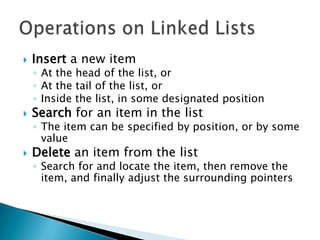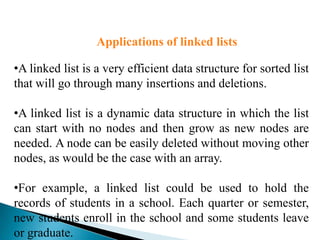Array implementation and linked list as datat structure
- 2. An array is a collection of elements of similar datatype. Contiguous memory allocation takes place. An array is a DS in which we can access every element directly using position variable . It is rather an organizational concept. Array elements can be accessed individually. Syntax: datatype nameofarray [dimension];
- 3. Two types of array- 1. Single dimensional single for loop. 2. Multidimensional nesting of for loop.
- 4. Array can be of integer ,character and string. Integer and character array can be implemented by same logic Implementation of string array is quiet different from the two. We can study the array implementation using integer array.
- 5. Creation of integer array int 7 a[0] i=0 a[10]={7,1,32,58,0,5,8,16,9,23} 14 a[1] i=1 ; 32 a[2] i=2 Integer array “a”. 58 a[3] i=3 It is of dimension 10 (from 0 0 a[4] i=4 to 9). 5 a[5] i=5 Take positing variable i. 8 a[6] i=6 Its storage will be continuous 16 a[7] i=7 20 bytes(2 bytes each). 9 a[8] i=8 23 a[9] i=9
- 6. 1. DECLARATION N SIZE 2. OPERATION Repeat for i= 0 to (size-1) arr[i]= num end repeat 3. OUTPUT RETURN(arr[i])
- 7. DECLARATION i rows j coloumn OPERATION ◦ Repeat for i=0 to (rows-1) Repeat for j=0 to (coloumn-1) Array[i][j]=num End repeat ◦ End repeat OUTPUT Return(Array[i][j])
- 8. No need to declare large number of variables individually. Variables are not scattered in memory , they are stored in contiguous memory. Ease the handling of large no of variables of same datatype.
- 9. Rigid structure. Can be hard to add/remove elements. Cannot be dynamically resized in most languages. Memory loss.
- 10. AS A DATA STRUCTURE
- 11. Each element (node) inside a linked list is linked to the previous node and successor (next) node. This allows for more efficient insertion and deletion of nodes. 5 3 14 2 continued
- 12. Each item has a data part (one or more data members), and a link that points to the next item. One natural way to implement the link is as a pointer; that is, the link is the address of the next item in the list. It makes good sense to view each item as an object, that is, as an instance of a class. We call that class: Node The last item does not point to anything. We set its link member to NULL. This is denoted graphically by a self-loop
- 13. Insert a new item ◦ At the head of the list, or ◦ At the tail of the list, or ◦ Inside the list, in some designated position Search for an item in the list ◦ The item can be specified by position, or by some value Delete an item from the list ◦ Search for and locate the item, then remove the item, and finally adjust the surrounding pointers
- 14. Suppose you want to find the item whose data value is A You have to search sequentially starting from the head item rightward until the first item whose data member is equal to A is found. At each item searched, a comparison between the data member and A is performed.
- 15. LOGIC FOR SEARCHING A LINKED LIST •Since nodes in a linked list have no names, we use two pointers, pre (for previous) and cur (for current). •At the beginning of the search, the pre pointer is null and the cur pointer points to the first node. •The search algorithm moves the two pointers together towards the end of the list.
- 16. Declaration ◦ Current 0 Searching ◦ for (current = first; current != NULL; current = current->next) ◦ if (searchItem == current(data)) ◦ return (current); ◦ Break Output ◦ return (NULL);
- 18. Insertion of an Element at the Head : Before the insertion: head next next next element element element Rome Seattle Toronto
- 19. Have a new node: head next next next next element element element element Baltimore Rome Seattle Toronto Node x = new Node(); x.setElement(new String(“Baltimore”)); The following statement is not correct: x.element = new String(“Baltimore”));
- 20. After the insertion: head next next next next element element element element Baltimore Rome Seattle Toronto x.setNext(head); head = x;
- 21. Deleting an Element at the Head : Before the deletion: head next next next next element element element element Baltimore Rome Seattle Toronto
- 22. Remove the node from the list: head next next next next element element element element Baltimore Rome Seattle Toronto head = head.getNext();
- 23. After the deletion: head next next next element element element Rome Seattle Toronto
- 24. Insertion of an Element at the Tail : Before the insertion: head tail next next next element element element Rome Seattle Toronto
- 25. Have a new node: head tail next next next next element element element element Rome Seattle Toronto Baltimore Node x = new Node( ); x.setElement(new String(“Baltimore”)); x.setNext(null); tail.setNext(x); tail = x;
- 26. After the insertion: head tail next next next next element element element element Rome Seattle Toronto Baltimore
- 27. Deleting an Element at the Tail : Deletion of an element at the tail of a singly linked list takes more effort. The difficulty is related with the fact that the last node does not have a link to the previous node which will become the new tail of the list.
- 28. Before the deletion: head tail next next next next element element element element Rome Seattle Toronto Baltimore
- 29. Remove the node: How can we find the new tail? head tail ? next next next next element element element element Rome Seattle Toronto Baltimore should be removed
- 30. Singly Linked Lists and Arrays Singly linked list Array Elements are stored in linear Elements are stored in linear order, accessible with links. order, accessible with an index. Do not have a fixed size. Have a fixed size. Cannot access the previous Can access the previous element directly. element easily. No binary search. Binary search.
- 31. Advantages of linked lists Linked lists are dynamic, they can grow or shrink as necessary Linked lists are non-contiguous; the logical sequence of items in the structure is decoupled from any physical ordering in memory CS314 Linked Lists 31
- 32. Applications of linked lists •A linked list is a very efficient data structure for sorted list that will go through many insertions and deletions. •A linked list is a dynamic data structure in which the list can start with no nodes and then grow as new nodes are needed. A node can be easily deleted without moving other nodes, as would be the case with an array. •For example, a linked list could be used to hold the records of students in a school. Each quarter or semester, new students enroll in the school and some students leave or graduate.


![ An array is a collection of elements of similar
datatype.
Contiguous memory allocation takes place.
An array is a DS in which we can access every
element directly using position variable .
It is rather an organizational concept.
Array elements can be accessed individually.
Syntax: datatype nameofarray [dimension];](https://image.slidesharecdn.com/arrayimplementationandlinkedlistasdatatstructure-120916130606-phpapp01/85/Array-implementation-and-linked-list-as-datat-structure-2-320.jpg)


![Creation of integer array
int
7 a[0] i=0 a[10]={7,1,32,58,0,5,8,16,9,23}
14 a[1] i=1 ;
32 a[2] i=2 Integer array “a”.
58 a[3] i=3
It is of dimension 10 (from 0
0 a[4] i=4 to 9).
5 a[5] i=5 Take positing variable i.
8 a[6] i=6
Its storage will be continuous
16 a[7] i=7 20 bytes(2 bytes each).
9 a[8] i=8
23 a[9] i=9](https://image.slidesharecdn.com/arrayimplementationandlinkedlistasdatatstructure-120916130606-phpapp01/85/Array-implementation-and-linked-list-as-datat-structure-5-320.jpg)
![1. DECLARATION
N SIZE
2. OPERATION
Repeat for i= 0 to (size-1)
arr[i]= num
end repeat
3. OUTPUT
RETURN(arr[i])](https://image.slidesharecdn.com/arrayimplementationandlinkedlistasdatatstructure-120916130606-phpapp01/85/Array-implementation-and-linked-list-as-datat-structure-6-320.jpg)
![ DECLARATION
i rows
j coloumn
OPERATION
◦ Repeat for i=0 to (rows-1)
Repeat for j=0 to (coloumn-1)
Array[i][j]=num
End repeat
◦ End repeat
OUTPUT
Return(Array[i][j])](https://image.slidesharecdn.com/arrayimplementationandlinkedlistasdatatstructure-120916130606-phpapp01/85/Array-implementation-and-linked-list-as-datat-structure-7-320.jpg)

























